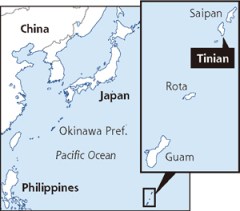Soldiers from Japan’s Western Army Infantry Regiment train at Camp Pendleton, Calif., earlier this month.
The prospect of U.S. and Japanese troops fighting side by side in the next land war in Asia — and heaven forbid the need for either — comes a step closer with a little-noted provision in U.S. realignment plans announced last week. The agreement to shift 9,000 Marines from Okinawa to other locations in the Pacific also includes plans to build joint U.S.-Japan training bases on American territory in the Northern Mariana Islands and perhaps elsewhere.
This would mark the first time that U.S. and Japanese troops routinely train together for combat operations and would dramatically deepen the connection between those forces. “This is a historic shift in the relationship,” says Noboru Yamaguchi, a retired lieutenant general in Japan’s Ground Self-Defense Force and now a professor at the National Defense Academy of Japan. “The fact that these will be joint facilities on U.S. soil makes the relationship much more of a two-way street. This is not just renting land to the Marines.”
(MORE: Okinawa Troop Withdrawal: Why the U.S. and Japan Have a Lot More Talking to Do)
The plan also calls for joint U.S.-Japan surveillance and reconnaissance operations in Japan’s southern islands — which include territory claimed by China and Taiwan — as well as transfer of patrol boats and other military equipment from Japan to “coastal” nations like the Philippines.
Prime Minister Yoshihiko Noda and President Barack Obama are expected to endorse closer cooperation and coordination between U.S. and Japanese forces following their meeting in Washington on Monday. (Noda and Obama endorsed the agreement during a joint appearance after their Oval Office meeting. “We have agreed to a new joint vision to guide our alliance and help shape the Asia-Pacific for decades to come,” Obama said.)
Although plans have not been finalized, a joint Japan-U.S. inspection team last week visited potential training sites on Tinian, Pagan and other islands in the Northern Mariana chain. It was the latest in a series of inspection trips to the islands in recent months. Negotiators have already agreed that some of the $3.1 billion that Japan has pledged to help pay for relocation of the Okinawa Marines can be used to build the joint facilities. Specific sites in the Marianas, which could include Guam, are to be identified by the end of the year.
The joint facilities would allow U.S. and Japanese forces to train together for combat operations on a regular basis and coordinate key battlefield issues like communications, logistics and artillery and air support.
(PHOTOS: The U.S. Military in the Pacific)

Yomiuri Shimbun
“This really creates an opportunity for significant deepening in our operational relationship together,” a senior U.S. defense official said at a Pentagon background briefing. The plan must be approved by Congress, which has commissioned an independent study of U.S. basing requirements in the Pacific; that study is expected to be completed in June.
About 50,000 U.S. troops are based in Japan, but because of political sensitivities and lack of space, most U.S. and Japanese forces do not routinely train together, nor have command and control structures been tightly integrated. But that is beginning to change.
Japanese ground troops began training with Marines at Camp Pendleton, Calif., two years ago, and Japanese F-15 pilots began using U.S. training ranges in Guam last summer. A joint U.S.-Japan air-defense headquarters opened at Yokota Air Base, near Tokyo, last month and a joint headquarters for the U.S. Army and Japan Ground Self-Defense Forces is scheduled to open at Camp Zama, also near Tokyo, later this year.
The realignment plan also represents a significant shift in U.S. strategy. The Marines in Okinawa, Guam, Hawaii and Australia would be organized as largely autonomous “air-ground task forces” that could be dispatched individually or collectively to trouble spots in the region.
(MORE: Why Okinawa Won’t Be Celebrating if 4,700 U.S. Marines Move to Guam)
Currently, the Marines in Okinawa are organized largely as the vanguard of a U.S.-based force that would reinforce the Korean Peninsula in the event of a major land war. The 31st Marine Expeditionary Unit, which conducts routine, ship-based patrols of the Asia-Pacific region, would continue to be based in Okinawa.
Tinian Island is located about 1,500 miles (2,400 km) southeast of Japan. It served as the launching point for U.S. air raids on Japan during World War II, including the atomic bombings of Hiroshima and Nagasaki. About two-thirds of the island is leased by the Department of Defense but is largely unused.
The first of about 200 Marines from Iwakuni Air Station, Japan, are currently on Tinian for a monthlong training exercise — the first there in more than a decade. No Japanese troops are participating, for now.
So far there has been little public discussion of the broadening military posture in Japan, which includes the easing of arms exports last December. The U.S. is committed by treaty to defending Japan, but Japan’s pacifist constitution bars the use of force outside Japanese territory.
Foreign Minister Koichiro Gemba dodged questions about potential conflicts last week, saying only that Japan must keep up with changes in the global security environment.
Whether U.S. and Japanese troops end up fighting side by side remains to be seen. Says Yamaguchi, a former lieutenant general in Japan’s ground forces, “You never know.”
PHOTOS: Hiroshima: Ground Zero 1945


